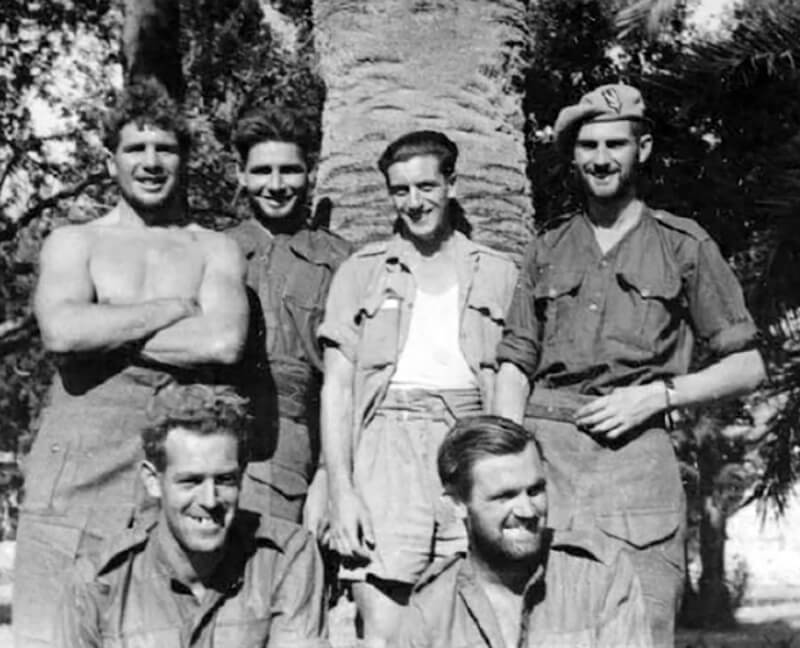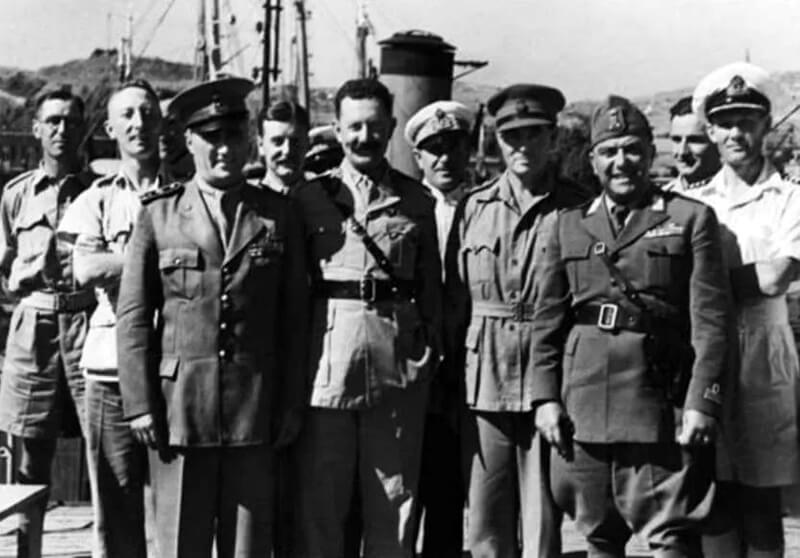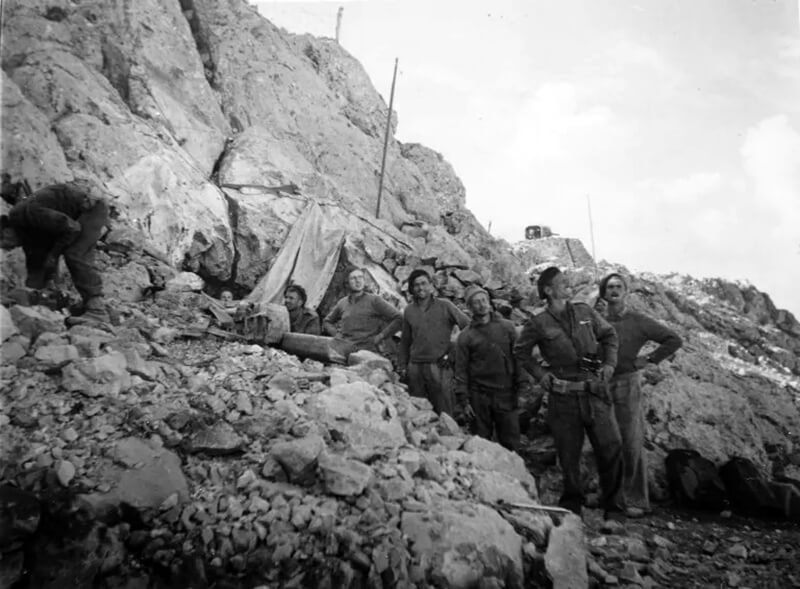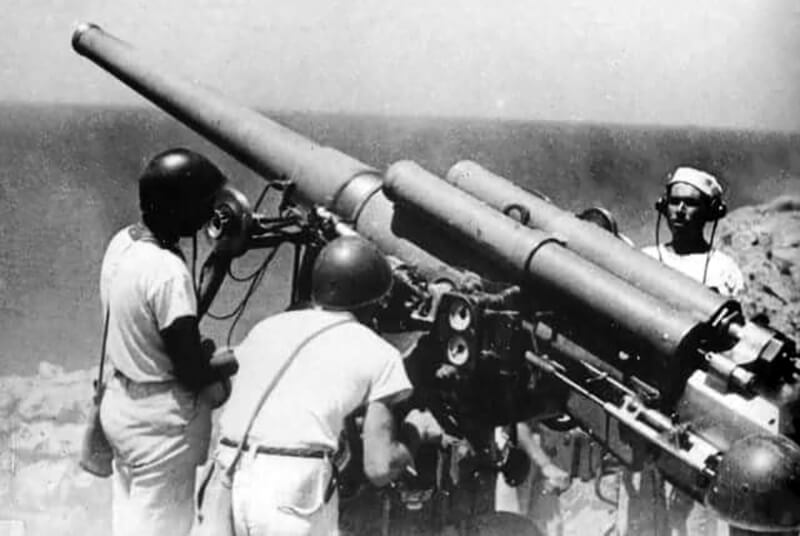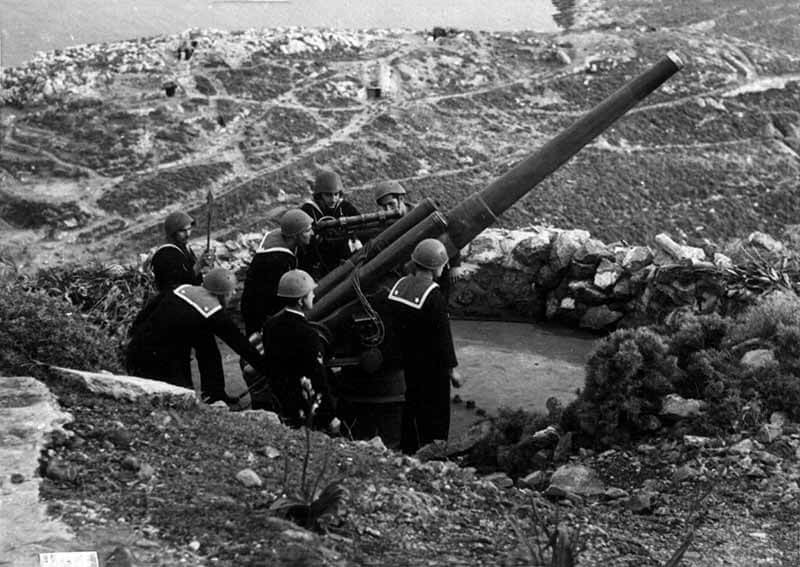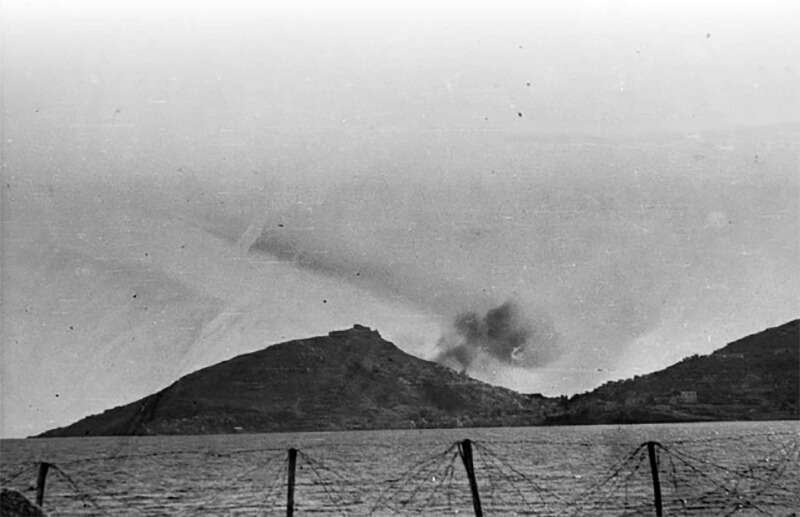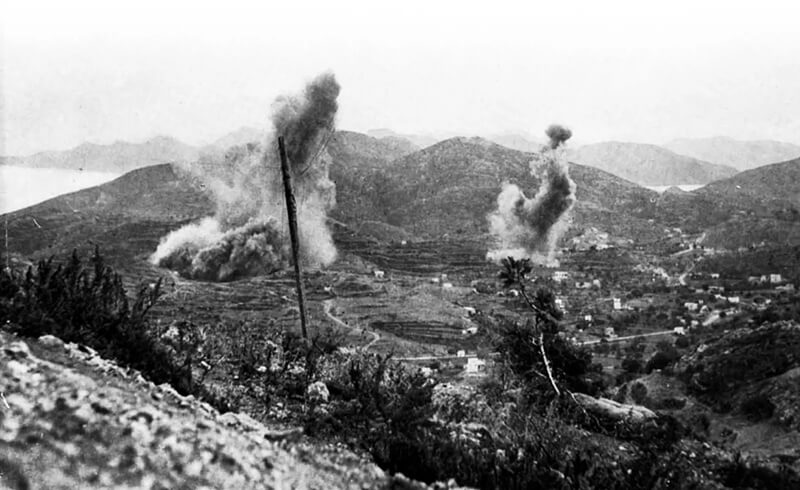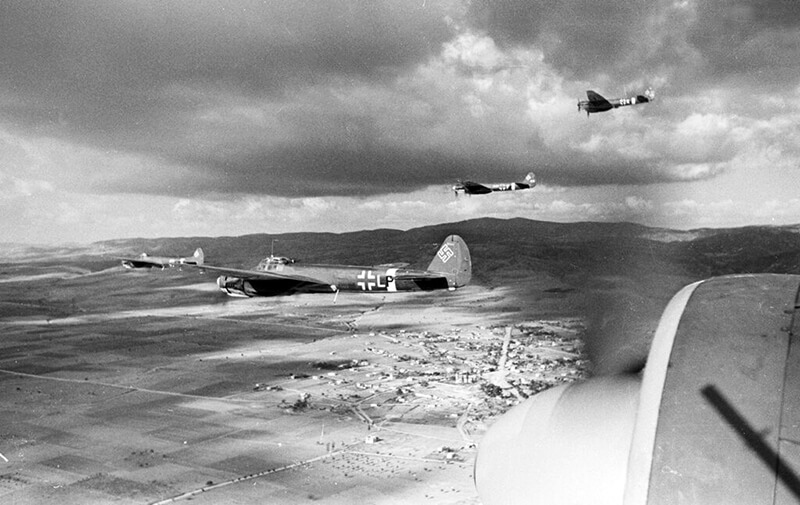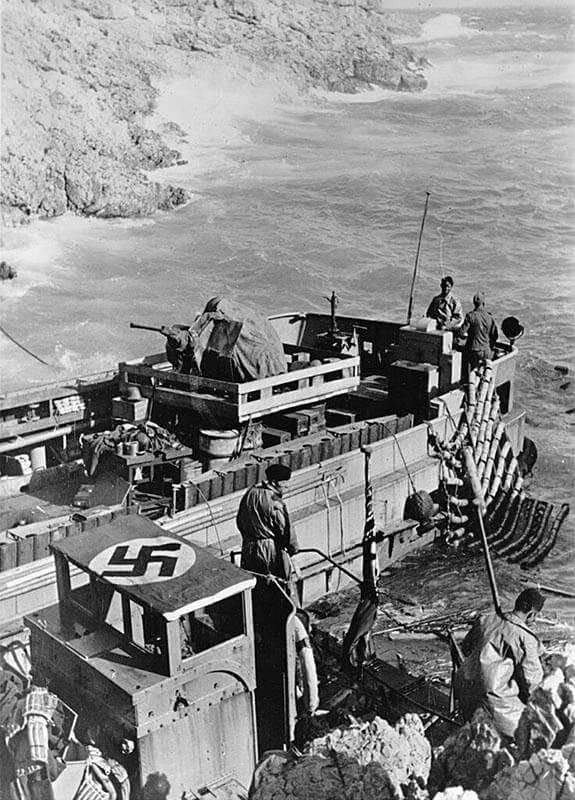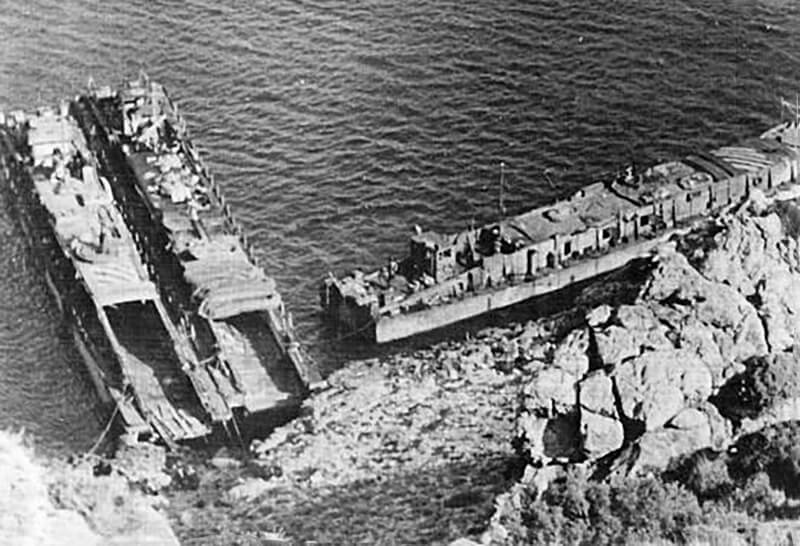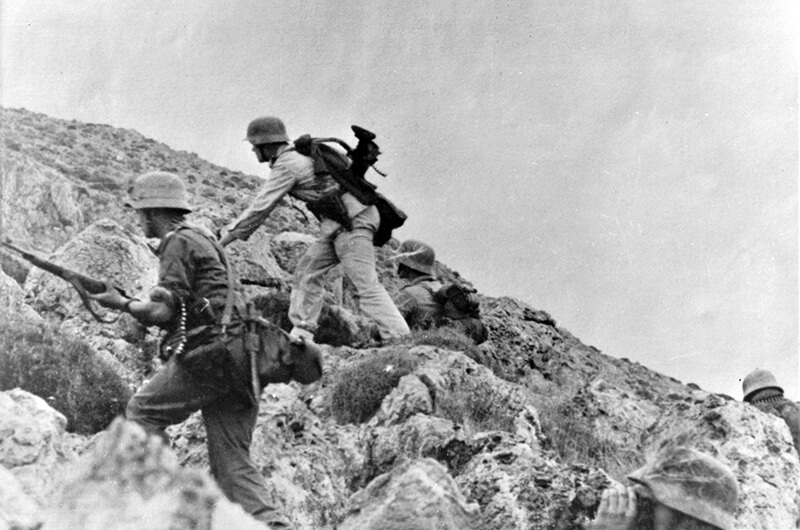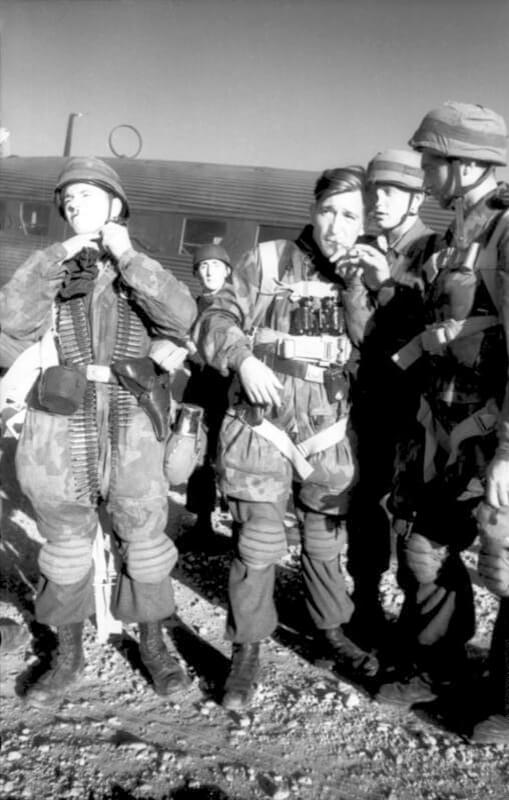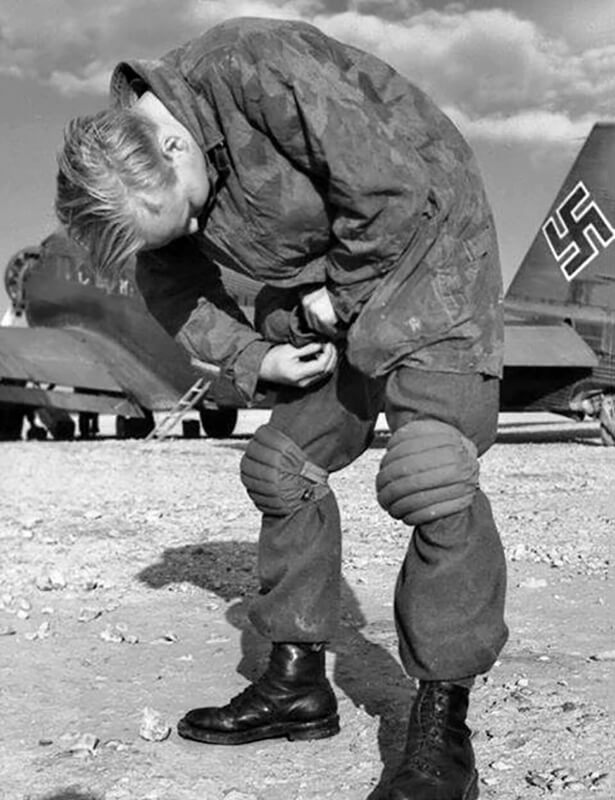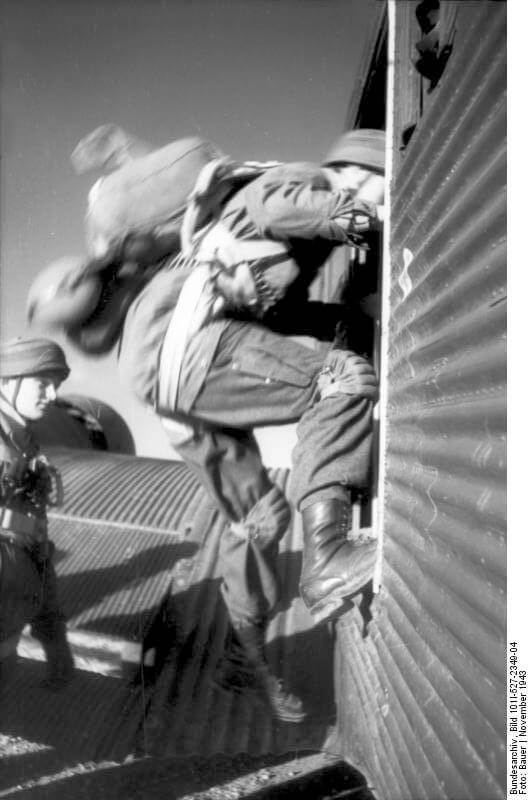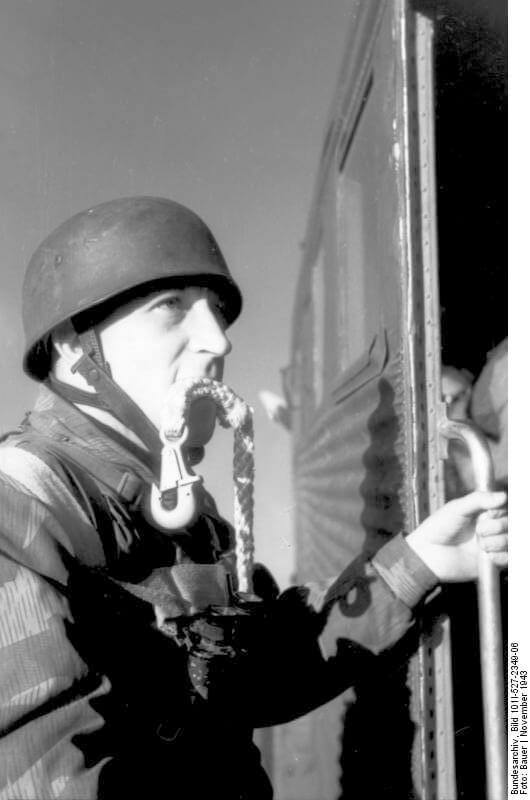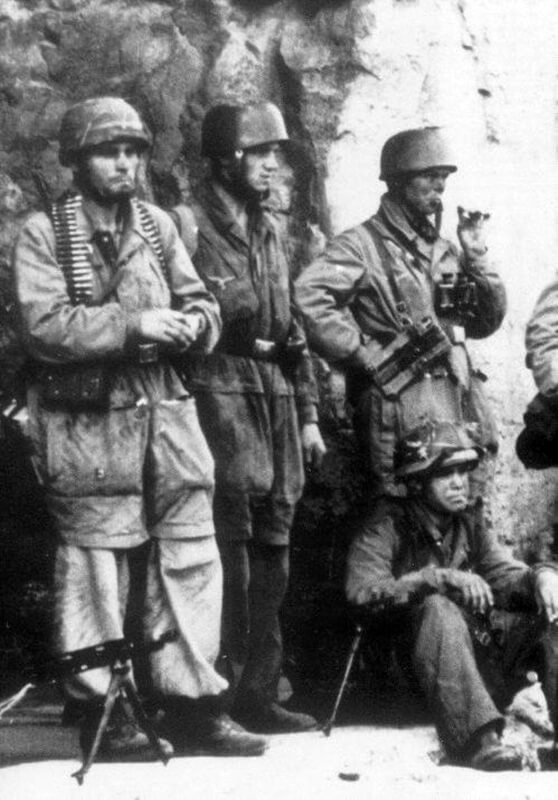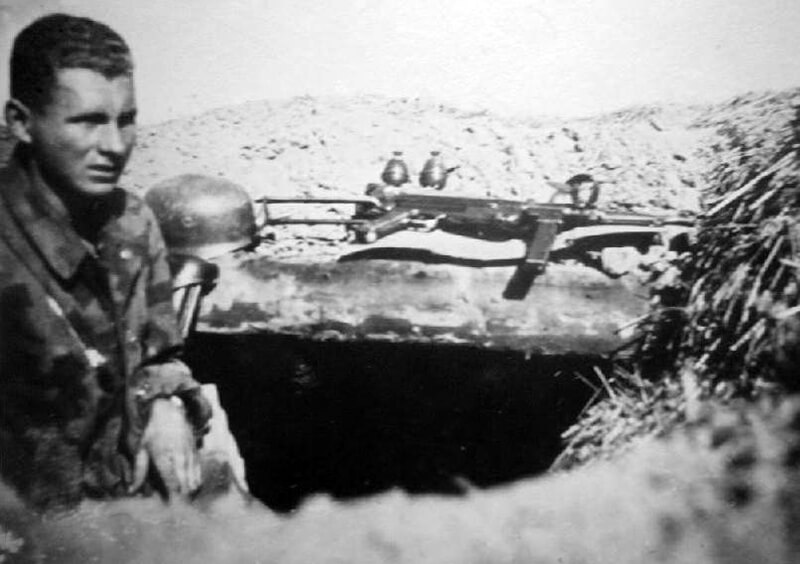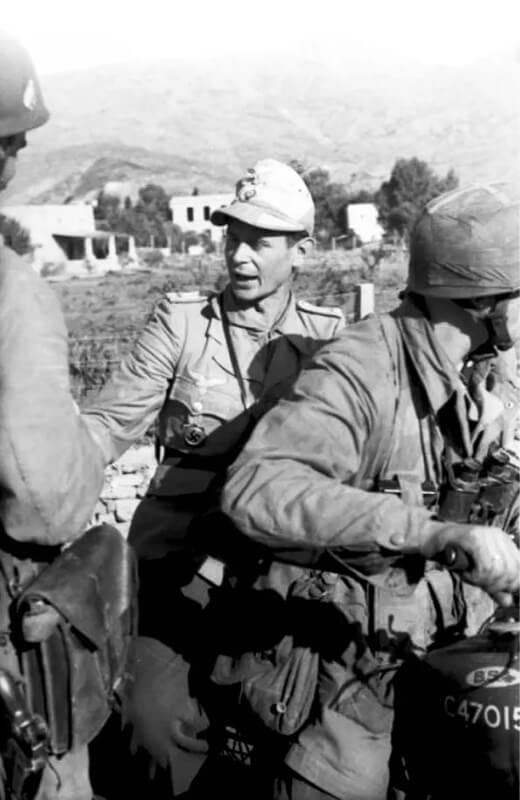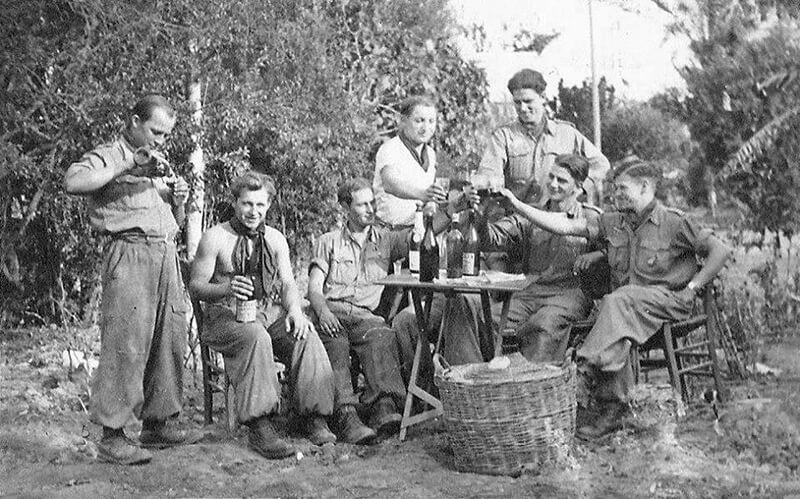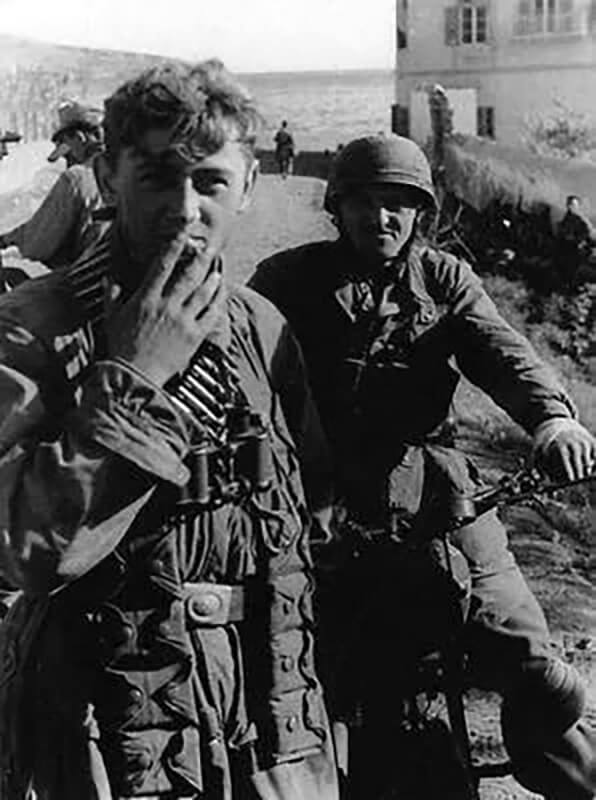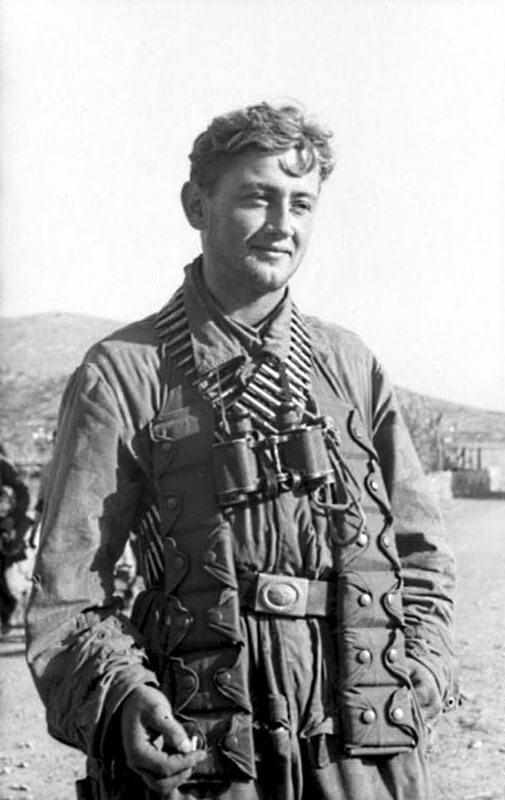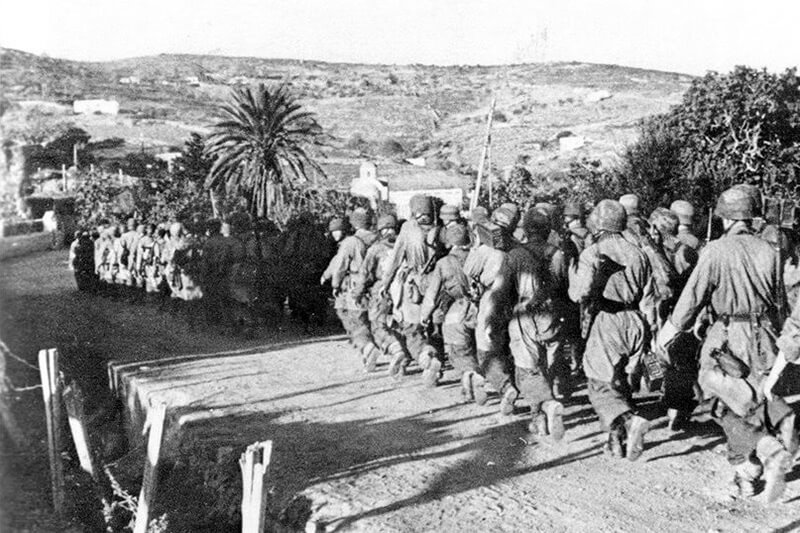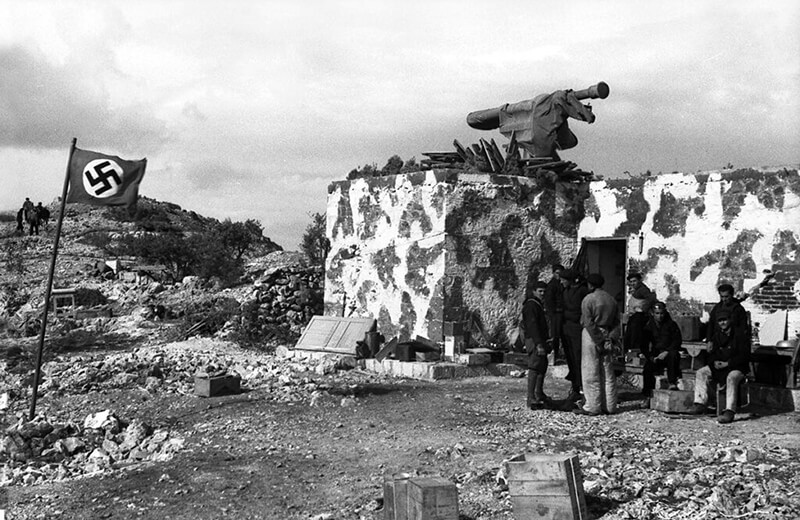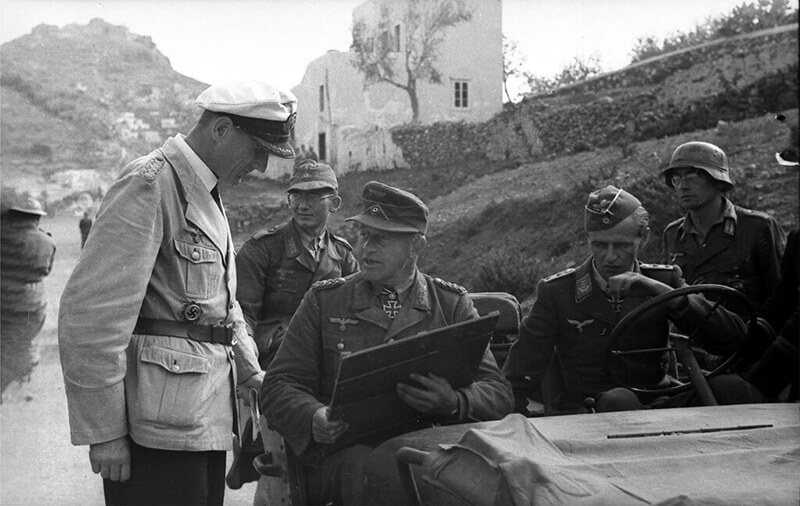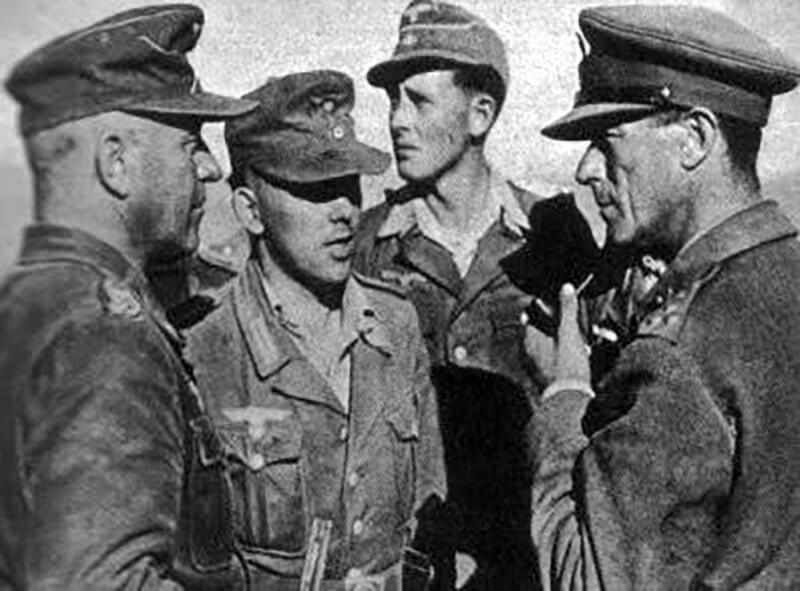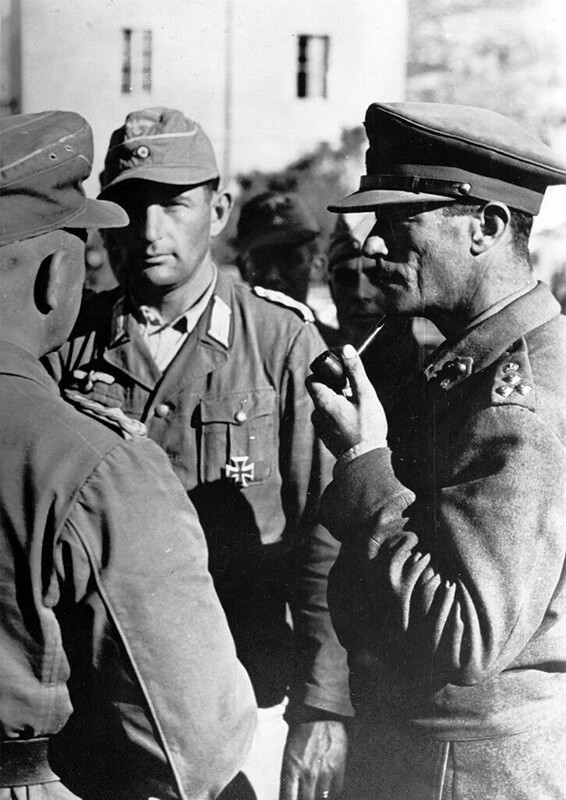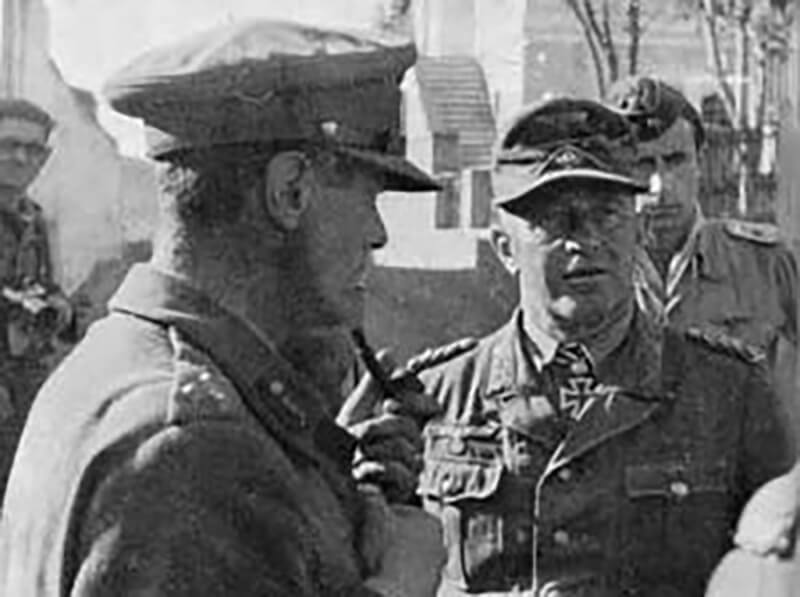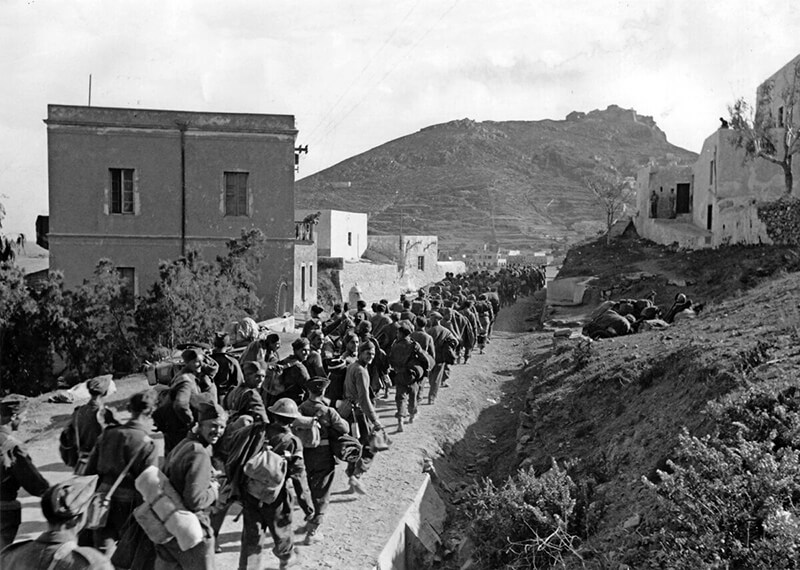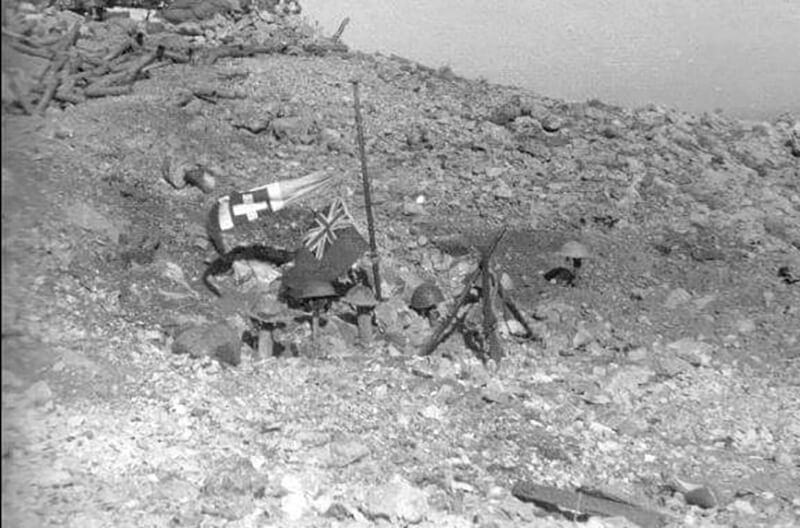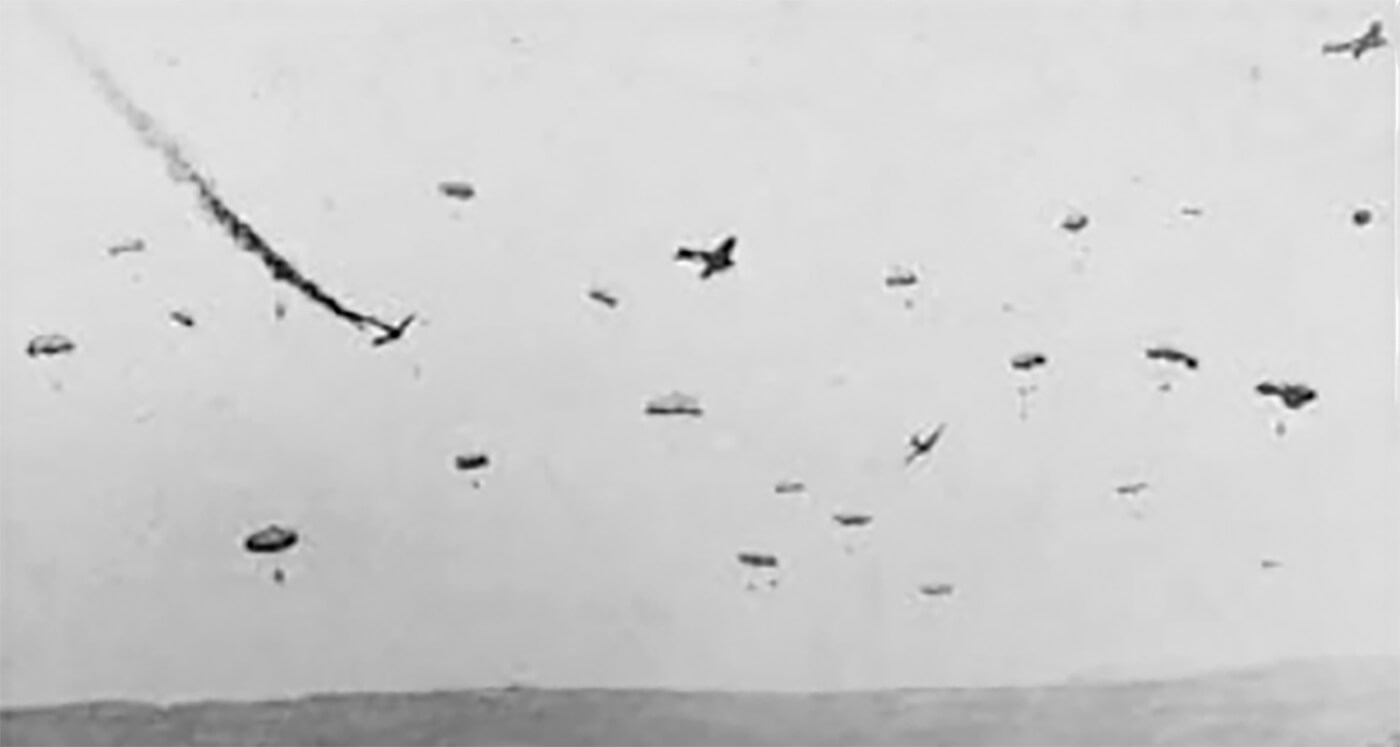| Page Created |
| May 24th, 2024 |
| Last Updated |
| May 27th, 2024 |
| Great Britain |
 |
| Germany |
 |
| Special Forces |
| Long Range Desert Group Special Boat Squadron Fallschirmjäger Brandenburg Division |
| September 15th, 1943 – November 16th, 1943 |
| Battle for Leros |
| Objectives |
British
- Assist the Italian Garrison of Leros in defending the Island.
German
- Occupy the Island of Leros.
| Operational Area |
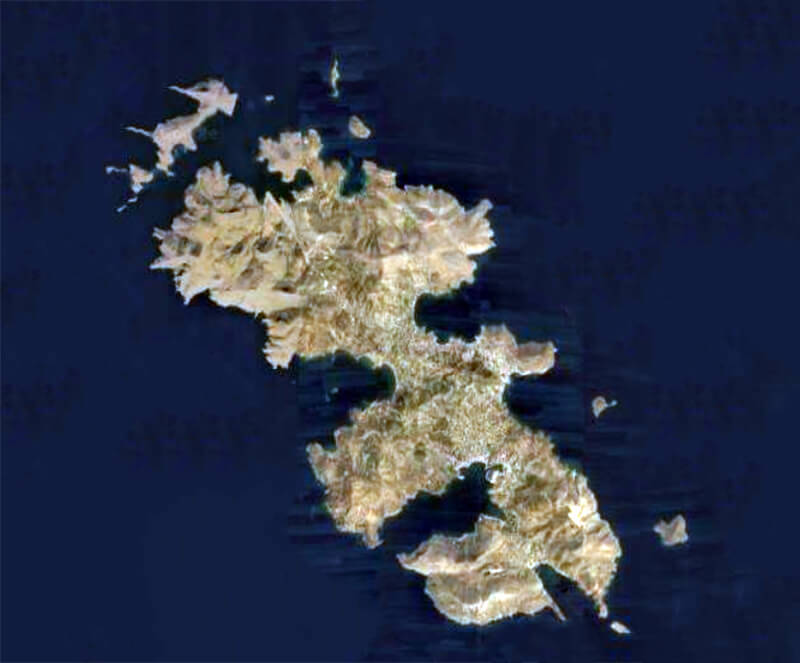
Leros, Aegean Sea, Greece
| Unit Force |
- Brigadier Robert Tilney
- B Squadron, Long Range Desert Group
- S Detachment, Special Boat Squadron
- 2nd Battalion, The Royal Irish Fusiliers, (under Lieutenant Colonel Maurice French)
- 4th Battalion, The Buffs (The Royal East Kent Regiment) (Lieutenant Colonel Douglas Iggulden)
- 1st Battalion, The King’s Own Royal Regiment (Lieutenant Colonel Lancaster)
- Company of the 2nd Battalion Queen’s Own Royal West Kent Regiment
- Mainland of Africa and in Cyprus based support aircraft.
- Dakotas C47’s
- Two day and two night Beaufighter Squadrons
- Wellington torpedo bomber Squadron
- Three Baltimore and one Hudson General Reconnaissance squadrons
- Detachment of Photographic Reconnaissance Spitfires
- No. 178 Squadron Royal Air Force and No. 462 Squadron Royal Australian Air Force of No. 240 Wing Royal Air Force (Liberators and Halifaxes)
- Wing of IX United States Bomber Command
- No. 7 Squadron South African Air Force
- No. 74 Squadron Royal Air Force
| Opposing Forces |
- Generalleutnant Müller
- III. Bataillon, Grenadier-Bataillon Rhodos
- II. Battalion, Grenadier-Regiment 16, 22. Infantrie Division
- II. Battalion, Grenadier-Regiment 65, 22. Infantrie Division
- I. Fallschirmjäger Regiment 2
- 1. Küstenjägerabteilung Brandenburg Division
- 3. Battalion,1. Brandenburg Regiment (Reserve)
- 15. Fallschirmjäger Abteilung, 4. Brandenburg Regiment (Reserve)
- I. and II. Gruppe Schlachtgeschwader 3 Gruppe Junker 87 D3 (close air support)
- II. Gruppe of Kampfgeschwader 51 Junker 88 (air strikes)
| Operation |
| Prelude |
The island of Leros lies fifty-six kilometres northwest of Kos. It stretches sixteen kilometres in length, with its width varying from 1.6 to 8 kilometres. Covering an area of fifty-three square kilometres, Leros boasts a coastline of seventy-one kilometres. The island is divided into three sections connected by two narrow isthmuses. Leros features nine bays, each with good landing beaches. The central section, situated between Alinda and Pandeli Bays, is home to the town of Leros. Controlling the Alinda-Gurna isthmus and the Rachi ridge effectively splits the island and grants dominance over it. A single north-south road traverses the island, but the rocky soil makes it impossible to establish entrenched positions.
In the prewar years, the Italians invest considerable time and effort into fortifying Leros, turning it into a naval base. However, by the time of the armistice, its strategic importance is waning, and Italian resources in the Aegean are limited. Leros serves as a submarine base, but by September 8th, 1943, no Italian submarines remain in the Aegean. Of the 4th Destroyer Squadron based in Leros, only one destroyer is present, along with eight boats from the 3rd Motor Torpedo Boat Flotilla. Additionally, seven Cant Z 501 seaplanes from the Air Force squadron are serviceable.
To defend the island, the Italians install numerous naval and antiaircraft guns. There are twenty-four batteries: three 152 millimetres, two 120 millimetres, four 102 millimetres, one 90 millimetres, and fourteen 76 millimetres, along with 17 searchlight positions. Despite these impressive batteries, some in Cairo believe Leros can be held against any German attack. However, the guns are in exposed positions, mounted openly, and have inferior sighting devices. Out of the total Italian strength of 8,000 men, 6,000 are navy personnel, many of whom are administrative staff. The army force of 1,200 men consists mainly of one battalion of the 10th Regina Infantry Regiment, one Blackshirt Company, and two companies of Marines tasked with guarding naval installations.
| September 13th, 1943 |
During the evening, Captain Lloyd Owen and around 100 men of the Long Range Desert Group arrive at the port of Castelrosso, the principal settlement in Castelorizzo, the most easterly of the Dodecanese islands, located just off the Vathi Peninsula on the Turkish mainland.
| September 14th, 1943 |
Captain Lloyd Owen recieves a signal from General Headquarters Cairo. The message reads:
“Long Range Desert Group Squadron will move at once to Leros to assist the Italian Garrison.”
Leros is an island which lies to the north, beyond German-held Rhodes, and the latest intelligence reports the imminent arrival of a German emissary to discuss the occupation of the island. Leros is crucial to whoever controls the Aegean, as it has a natural harbour and a well-sheltered seaplane base.
With scant information and uncertainty about how the Italian garrison will receive them, Captain David Lloyd Owen faces the additional problem of transport. He informs Cairo that the sloops have returned to Haifa and it is impossible to reach Leros quickly with only small caïques available.
However, there is an Italian fast motor launch and a seaplane. The latter is brought from Rhodes by Major The Earl Jellicoe after his gallant but unsupported attempt to persuade the large Italian garrison to overcome the smaller German force on the island. Major George Jellicoe, dropped in by parachute, has sent many signals to Cairo requesting a few troops to assist him, but his entreaties are ignored.
Captain David Lloyd Owen believes the failure to control Rhodes, the largest and most important of the Dodecanese Islands, is a significant blunder. Securing the airfields there should indicate the necessity of immediate action; without such control, the Aegean operations are likely doomed unless Turkey can be persuaded to join the Allies.
Determined to reach Leros, Captain Lloyd Owen arranges for Captain Alan Redfern, with a wireless set, to go there in the seaplane. Redfern will inform him of the situation, and he will follow with the Squadron. Unfortunately, the seaplane, crewed by reluctant Italians, taxis into an Royal Air Force Sunderland that has just arrived from Cairo, rendering it unserviceable.
Captain Lloyd Owen decides to use the Italian motor launch, taking as many men as it can carry. They leave at dusk, with a Royal Navy coxswain to navigate, an engineer in the engine room, and David Lloyd Owen armed with a pistol beside the skipper. They do not trust their new co-belligerents and have no desire to be taken to Rhodes.
Under a clear, moonlit sky, they speed past Rhodes, witnessing fires from a recent Royal Air Force raid. Behind them, they see Royal Air Force transport planes en route to drop a company of parachutists on the airfield at Cos.
| September 15th, 1943 |
Captain Alan Redfern and the Italian admiral Luigi Mascherpa, commander of the Italian troops on Leros, welcome the motor launch with the Long Range desert Group on it, when it arrives at Leros. Admiral Mascherpa is initially unimpressed with the strength of the British invasion party. However, he soon realises that the Long Range Desert Group is just the advance guard. Within days, three Royal Navy destroyers and a brigade will arrive in Leros harbour, significantly bolstering the invasion force.
| September 17th, 2024 |
The British 234th Infantry Brigade under Major General F. G. R. Brittorous, arrives from Malta, secure the islands of Kos, Kalymnos, Samos, Leros, Symi, and Astypalaia. They are supported by ships from the British and Greek navies and two Royal Air Force Spitfire squadrons stationed on Kos. In response, the Germans rapidly mobilise.
| September 21st, 1943 |
A Squadron of the Long Range Desert Group departs from Haifa, Palestina, ten days after B Squadron, sailing on the Greek destroyer Queen Olga in convoy with three other destroyers.
| September 22nd, 1943 |
The convoy with A Squadron of the Long Range Desert Group reaches Portolago, Leros, during an air raid. Despite the attack, minimal damage occurs, allowing immediate unloading of stores and the establishment of a camp at Alinda Bay on the island’s eastern side.
| September 23rd, 1943 |
The German Generalleutnant Friedrich-Wilhelm Müller, commander of the German 22. Infantrie Division in Crete, is ordered to capture Kos and Leros.
| September 26th, 1943 |
After days of dropping threatening leaflets, the Luftwaffe unleashes continuous attacks on Leros, enjoying complete air superiority. On that day, Junker 88 bombers sink the Greek destroyer Vasilissa Olga, the British destroyer H.M.S. Intrepid, and the Italian MAS 534 inside the harbour of Lakki. The submarine base, the barracks of the naval base, the workshops, and four of the five fuel depots (but not the one containing fuel) are destroyed. Seven German bombers are shot down.
| September 27th, 1943 |
The Second Battalion, Royal Irish Fusiliers, under the command of Lieutenant Colonel Maurice French, together 130 men from the Long Range Desert Group, are deployed to Leros. French, lacking sufficient forces to occupy the entire island, decides that the best way to defend Leros is to occupy and hold the highest point in the central sector. Without proper means of communication, he regards his force as a flexible reserve behind the static Italian defences.
In September and October, Force 292, actually III Corps Headquarters, controls the operations in the Aegean, with the 234th Infantry Brigade in charge of Leros.
The Long Range Desert Group are instructed to revert to their proven expertise in reconnaissance. They focus on the shipping lanes around islands such as Pserimos, Kalymnos, Kythnos, and Syros.
In the weeks to follow, more British reinforcements arrive in Leros after it is decided that the island will be held. The main units under 234th Infantry Brigade include the Second Royal Irish Fusiliers, the Fourth Royal East Kent Regiment of the Buffs, the First Battalion King’s Own Royal Regiment, B Company of the Second Royal West Kent Regiment, a detachment from the 28th Heavy Antiaircraft Battery, part of the 3rd Light Antiaircraft Battery, and supporting elements.
Throughout September and October, the defensive preparations on Leros continue. The British and Italian forces work together to strengthen their positions and establish supply lines. The arrival of additional troops boosts morale and enhances their defensive capabilities. However, the lack of proper communication equipment remains a significant challenge. French’s strategy to hold the high ground in the central sector proves crucial as it provides a vantage point for observing enemy movements and coordinating defensive actions.
As the situation intensifies, the island’s defenders brace for the imminent German assault. The combination of British and Italian forces, along with specialised units like the Long Range Desert Group, demonstrates a determined effort to hold Leros against the Axis onslaught. Despite the challenges, the defenders remain resolute in their mission to secure the island and deny the Germans a strategic foothold in the Aegean.
| October 4th, 1943 |
S detachment of the Special Boat Squadron under Captain David Sutherland arrives at Leros, disembarking at the deep-water port of Lakki (known to the Italians as Porto Lago) on the southwest coast. The all-weather harbour Porto Lago Bay is located in the southwest corner.
Sutherland humorously compares the island’s shape to “a large cowpat trodden on by two feet!” Due to its rocky and undulating terrain, Leros lacks an airfield. However, during their thirty-one years of occupation, the Italians have installed formidable coastal batteries overlooking the island’s six bays.
Throughout October, the Special Boat Squadron and the Long Range Desert Group remain in their defensive positions. They lose mobility due to overwhelming German air superiority. It seems clear to David Lloyd Owen that they should cut their losses and withdraw from the Aegean before it is too late. Turkey will not openly join their side, and without its bases, they can only flounder. All this is very obvious to them on the ground.
They cannot train properly because the island is too small. They cannot operate on other islands, as the General Officer Commanding is not willing to spare a single man from the defence of Leros when the inevitable showdown comes. The days drag on under constant air attack. Each morning, they ‘stand to’ to greet the expected invasion in the cold October dawn. Everyone is tired and irritable among the three Regular regiments on the island and on the Staff. Only the inherent discipline of these regiments keeps morale at a reasonable level, as there is little encouragement from above.
| October 5th, 1943 |
At 09:00, a squadron of Stukas attacks Leros just as Captain Sutherland is discussing the island’s defences with Captain Thomas Belcher of No. 30 Commando. A bomb lands 45 metres from Captain Sutherland, leaving him temporarily deaf, badly shaken, and coated in white dust. He survives, but Captain Belcher, two of his commandos, and Sergeant Ernest Hawkes of the Special Boat Squadron are killed. Captain Sutherland is evacuated to Samos that evening, while his men endure sporadic Stuka attacks for the rest of the month.
Also on Leros throughout October is Dick Holmes, one of the 12 Special Boat Squadron men manning the roadblock on the Partini–Alindo Road. The men use Germans dropping leaflets for toilet paper. Hank Hancock spends his time painting watercolours of the island’s landscapes and noting the best places for defence when the Germans come.
Meanwhile, The German General Mueller prepares for another assault on Leros. He plans to use the same forces that assaulted Kos, replacing the Kos troops with the IX Battalion of the 999th Fortress Infantry Division.
| October 6th, 1943 |
The New Zealand T1 Patrol, led by Captain Charles Saxton, reports a convoy of German landing craft. This intelligence leads to the Royal Air Force destroying the convoy near Stampalia. Survivors swim ashore and are captured by the Long Range Desert Group. H.M.S. Hedgehog is sent to collect survivors but develops engine trouble and puts in at the Greek Island of Levitha.
When radio contact with H.M.S. Hedgehog is lost, the British assume the German prisoners have taken control.
| October 7th, 1943 |
Two British cruisers and two destroyers intercept the first troop replacement convoy, sinking two transports and five out of six ferry lighters. The British submarine H.M.S. Unruly surprises another convoy, sinking the minelayer “Bulgaria” carrying 350 troops. With combined losses of 659 troops from both convoys, the reinforcements for Kos and the landing crafts for Leros are lost, resulting in the postponement of Unternehmen Leopard. In retaliation, the German Luftwaffe severely damages the destroyer H.M.S. Penelope and the anti-aircraft cruiser H.M.S. Carlisle, and sinks the destroyer H.M.S. Panther. Hitler rejects a request to attack British ships in Turkish waters.
| October 23rd, 1943 – October 25th, 1943 |
A Detachment from the Long Range Desert Group, under Captain John Olivey, is ordered to Levitha to suppress the uprising. Olivey’s force of fifty men, including New Zealand troops under Lieutenant Jack Sutherland, land on opposite ends of the island.
Captain Olivey’s group secures an ancient fort but soon encounters heavy German resistance, including mortar fire. They capture three German prisoners, but the situation deteriorates as more German troops arrive. Lieutenant Kay and his men are captured, and Olivey narrowly escapes, hiding with Rhodesian soldier Karrikie Rupping.
Captain Sutherland’s group faces relentless attacks and runs out of ammunition, forcing them to use captured German weapons. A ceasefire is arranged to evacuate the wounded, but they ultimately surrender as German forces overwhelm them.
Captain Olivey and Rupping evade capture and reunite with Captain Dick Lawson and a few others. Despite efforts, they realise they have lost forty-three men for no gain. Back at Long Range Desert Group Headquarters at Leros, Olivey reports to new commander Lieutenant Colonel Easonsmith.
This is a bitter blow to the Long Range Desert Group. They lose more men in a few hours than in all the previous years combined. But recriminations will not bring them back, and they endure this loss with as much grace as they can summon.
Soon after this costly and fruitless débâcle, Brigadier George Davy, then Director of Military Operations in Cairo, pays them a visit. He arrives very wet and rather oily after having his destroyer sunk beneath him on the way. He is alive to the problems they face and sees how wastefully they are being employed. The then General Officer Commanding Aegean is replaced as a result of this visit, and a little sanity returns to the garrison on Leros.
| November 1st, 1943 |
A new Headquarters Command Aegean, under Major General H.R. Hall, is established with his headquarters and staff in Samos. Lieutenant Colonel Robert Tilney is appointed to command 234th Infantry Brigade and becomes Fortress Commander Leros. Admiral Luigi Mascherpa holds the overall command of the Italian forces in Leros, and the Badoglio government places him and his garrison under Tilney’s command without conditions.
Brigadier Robert Tilney reorganises the defense of Leros with the slogan, “No enemy shall set foot on this island unless to be a prisoner of war.” Facing the coastal defense dilemma of whether to attack the enemy at the beaches or hold back a main force, Tilney chooses to attack on the beaches. This decision is based on the German command of the air, occupation of neighboring islands, and the ability to quickly bring reinforcements. Due to uncertainties in ammunition supply and German air and naval superiority, a prolonged battle would disadvantage the defenders, necessitating a swift defeat of the enemy at the beaches.
Brigadier Tilney divides Leros into three sectors: the north held by the Buffs, the center by the Royal Irish Fusiliers and B Company of the Royal West Kent Regiment, and the south by the King’s Own Royal Regiment, with an additional King’s Own Royal Regiment company as a central reserve. Each battalion is organised into company sectors. Four 18/25 pounder field guns are positioned in the central sector, and thirty machine guns are distributed to the battalions. Brigadier Tilney’s Headquarters is located in a tunnel on Meraviglia Hill in the central sector.
The Long Range Desert Group is assigned to principal batteries to boost Italian morale, while the Special Boat Squadron acts as a mobile reserve against paratroops. Recovered from his injuries, Captain Sutherland rejoins his detachment on Leros and prepares for the inevitable invasion, with tension high and nerves strained due to constant warnings of an impending attack.
However, Tilney’s plan has significant weaknesses that the Germans exploit. By defending the beaches, he spreads his forces thin along the lengthy coastline, making them weak overall. His small central reserve of one company is insufficient to significantly impact the battle. The central sector, including the critical Rachi Ridge, is not adequately organised for defence, effectively ruling out the potential for airborne landings. Consequently, the plan lacks a strong base and the flexibility needed for an effective reserve force.
| November 4th, 1943 |
Lieutenant Colonel John Easonsmith asks Major Lloyd Owen to return to Cairo. Ostensibly, this is to collect more recruits and start a training organisation for them, but secretly Lieutenant Easonsmith has decided to get him out of Leros for other reasons. One reason is that they know disaster is imminent, and he wants Major Lloyd Owen to do all he can to mitigate it. The second reason is that the authorities in Cairo need to be made more aware of the true state of affairs in Leros, and it is thought that Major Lloyd Owen might be able to update them.
During the evening on the Meriviglia feature, Major Lloyd Owen bids farewell to Lieutenant Colonel John Easonsmith. Somehow, he senses that it will be the last time he sees him. They talk about home and Easonsmith’s family, to whom he is devoted. They discuss what they will do when it is all over and share ideas for the future of the Long Range Desert Group, which means so much to both of them. Having been through a lot together in the desert, Major Lloyd Owen hates leaving at this stage, but there is no alternative. He knows one of them has to go, and Lieutenant Colonel Easonsmith certainly never would.
| November 5th, 1943 |
Major Lloyd Owen boards an Italian submarine, and after five daunting days, he arrives in Haifa and travels to Cairo.
Ferry lighters from the German Kriegsmarine begin moving eastward. The German convoy moves undetected to Paros, then to Naxos, Amorgos, Astypalaia, Levitha, and reaches the jump-off points at Kos and Kalymnos on the evening of November 11th, 1943. The British fail to intercept the convoy, inflicting only minor losses.
The German Kriegsmarine transfers the ferry lighters from the Danube via the Black Sea and the Dardanelles, camouflaged as civilian vessels. The army transports the 780th Assault Engineer Company from Denmark to Piraeus by rail, along with thirteen landing boats. These craft are to transport II Battalion of the 22. Luftwaffe Feld Regiment from Piraeus to the Dodecanese. Agents report landing exercises from landing craft in the Lavrio Gulf south of Athens.
Meanwhile, Major General F.G. Brittorous is replaced by Major General H.R. Hall as the commander of the Aegean forces.
| November 7th, 1943 |
A part of A Squadron of the Long Range Desert Group is withdrawn from Leros. Lieutenant Aitken and twenty men from R1 patrol and squadron headquarters leave for Palestine by destroyer.
| November 8th, 1943 |
R2 patrol of the Long Range Desert Group, reconstituted with eight New Zealanders and two Englishmen under Second-Lieutenant R. F. White, relieve T1 patrol at the Scumbardo coastal defence battery position, and T1 moves to an olive grove on the northern side of Alinda Bay, where they are joined by T2 when they return from the Island of Seriphos the next day.
| November 10th, 1943 |
As Major Lloyd Owens of the Long Range Desert Group arrives in Haifa, Palestine, the German Admiral Lange reports that the required landing craft are in position, and Army Group E sets the date for Unternehmen Leopard on November 12th, 1943. The Germans form five groups, each named after its commander.
The initial wave of the operation unfolds with meticulous planning, each Kampfgruppe (combat group) assigned specific objectives. Named after their commanders, these groups set out with detailed assault plans:
Gruppe Schadlich, the I. Küstenjäger Abteilung, Brandenburg, led by Leutnant Hans Schadlich, departs from Kalymnos. They land in Pandeli Bay at the foot of Mount Appetici. Their mission is to capture Battery Lago on the mountaintop and proceed to take Leros town. As they advance, their objective is clear: secure the town and establish a foothold.
Simultaneously, Gruppe von Saldern, under Major Sylvester von Saldern, launches its operation. With forces from II./Grenadier Regiment 65 from Kos and II./Luftwaffen-Jäger-Regiment 22 from Kalymnos, they aim to land in Grifo Bay and on two northern beaches. Their goal is to capture Battery Ciano on Mount Clidi and occupy Alinda Bay, preparing the way for the landing of reinforcements.
Meanwhile, Gruppe Doerr, commanded by Hauptmann Erwin Doerr, sets sail from Kalymnos towards Palma Bay. Their target is the Farinata batteries on Mount Marcello and PL906 on Mount Muplogurna in the northwest. As they land, they swiftly move to capture these strategic positions.
Gruppe Aschoff, the II. /Grenadier Regiment 16 under Hauptmann Philipp Aschoff, also departs from Kalymnos. Their landing zones are in the southern part of Gurna and the small bays of Drimona and Cefalo. Their mission is to secure these areas and fortify their positions.
Concurrently, Gruppe Kühne, the I. /Fallschirmjäger-Regiment 2 led by Hauptmann Martin Kühne, departs from Athens-Tatoi. They perform a parachute drop near Mount Rachi, aiming to capture Battery PL211. Their mission also includes attacking another battery position on Mount Meraviglia. Their airborne assault is critical in disabling key defensive positions.
In Athens, reserves are on standby. III. Bataillon/Jäger-Regiment 1 Brandenburg and 15. Fallschirm-Kompanie/Jäger-Regiment 4 Brandenburg are prepared for deployment. The general staff, artillery, anti-tank guns, flak, and engineers are set to land with the second wave at Alinda, ready to provide crucial support and reinforcements. The operation proceeds with precise coordination, each Kampfgruppe executing their assigned tasks to secure strategic points on Leros, paving the way for a successful campaign.
Generalleutnant Müller aims to achieve maximum surprise against the prepared island by landing his first wave on the eastern side. The main effort focuses north of Alinda Bay to capture Clidi, key terrain in the northern sector. The British, considering Clidi unscalable, leave it thinly defended. However, the main objective of Generalleutnant Müller’s plan is to capture the narrow isthmus between Alinda and Gourna Bays, securing the island’s center and splitting it into two parts.
| November 11th, 1943 |
Resuming heavy bombing in early November, the German Lutwaffe has destroyed 30 of the 58 anti-aircraft batteries by this date, making the invasion imminent.
Major General Hall, the commander of the Aegean forces, establishes his headquarters on Samos, unaware that the German assault is imminent the following day. Brigadier R.A.G. Tilney is tasked with defending Leros and remains as the fortress commander. Upon his arrival, he finds Italian morale very low. The Italian soldiers lack confidence in their officers, who in turn have little respect for the British administration. The loyalty of a small number of Italians is questionable, and the fighting reliability of the majority is uncertain. Under these conditions, it is clear that little reliance can be placed on the Italian garrison, necessitating a defense plan that accounts for this.
Despite these challenges, the Italian troops man the big 152 millimetres naval coastal defense guns on the heights and the smaller emplacements guarding the bays and harbors. With the new British leadership, relations with the Italians improve, leading to better organization of the island’s defense.
Five Long Range Desert Group patrols are assigned to the gun battery positions. They use the heights as coastal observation points and work to boost the morale of their new allies, ensuring the effectiveness of the guns and their crews. The initial patrols on watch are:
- R1 led by Lieutenant D.J. Aitken
- R2 led by Lieutenant J.M. Sutherland
- X1 led by Lieutenant R.A. Tinker
- X2 led by Captain J.R. Olivey
- Y2 led by Lieutenant J. Kay
The remaining patrols, Y1 under Captain M.P. Stormonth Darling, S2 under Lieutenant S. Eastwood, and T2 under Lieutenant M.W. Cross, are stationed at the north and south ends of the island. The squadron commanders are prepared to form a rendezvous point for the other patrols in the event of an attack.
Major George Jellicoe now commands the 50-strong Special Boat Squadron force on Leros and sees the hopelessness of the situation. He sends some of his most reliable men, including Andy Lassen, Jack Nicholson, Doug Wright, Dick Holmes, and Porter Jarrell, to Samos to evacuate wounded British soldiers to the Turkish mainland.
Captain Sutherland departs Leros for Turkey to make evacuation arrangements with Lieutenant-Commander Croxton of the Royal Navy. His patrol sails from Leros at 23:00 in a wooden caique, cruising south-east at 4 knots. Passing Kalymnos, Sutherland spots vessels heading in the opposite direction, the first wave of a German seaborne assault group from Kos Island.
| November 12th, 1943 |
Major Lloyd Owens arrives at Cairo. He is fortunate to have a wireless set directly in touch with the Long Range Desert Group in Leros, providing him with both interesting and up-to-date news, as the battle for Leros begins that very same day.
That evening, David Lloyd Owen drafts a “Most Secret and Officer Only” signal to be sent from General Headquarters to the Fortress Commander. He takes it to the Director of Military Operations for approval before dispatch. The wording of that signal is as follows:
“In unlikely event of Leros being overrun and evacuation of survivors being necessary what are your plans. If you require assistance signal RV’s and other details. If communications are cut caïques will visit Pega, San Domineca, Scrofe nightly from night 14/15 if situation appears to us to warrant it.”
The word “unlikely” is inserted into his draft; and the three place names are islands a short distance from Leros. He keeps a copy of that signal, and at the bottom of it he writes:
Despite all my efforts this signal was never sent until just before the end of the battle when all ciphers had been burnt and then in plain language in a disguised code. As a result many valuable lives were lost.
At 04:45 the German landing force comprising of fifteen landing craft, each carrying about fifty men, approaches Leros from the north over a calm sea. In the Eastern Kampfgruppe Von Saldern and Doerr attempt to land but are repulsed by the East Kent Regiment on all landing beaches except Grifo Bay. Lieutenant Colonel Douglas Iggulden, commanding the East Kents, remains unaware of the enemy landing there until 10:00, when the central reserve arrives to counterattack without success. In Pandeli Bay in the south, the Brandenburgers seize Apetiki hill. A company of the Royal Irish Fusiliers counterattacks and contains the enemy, but an order for the Royal Irish Fusiliers’s reserve company to attack is never received, losing the chance to repel the landings. As a result, the Germans establish two footholds on the island.
The Western Battle Group faces heavy fire from Italian batteries and is driven off, ordered to reinforce the Eastern Battle Group the next day. The British, believing no place on the island suitable for landing paratroops, are shocked when about 14:30 that afternoon, forty Junker 52 transport aircraft, fly in at 150 metres in line astern across the island’s narrow waist between Alinda and Gurna Bays. The 470 Fallschirmjägern of the Brandenburgers under the command of Hauptmann Martin Kühne drop at Gourna Bay at 15:00 hours.
These Fallschirmjägern are immediately engaged by the troops in the area, including the composite Long Range Desert Group-Special Boat Squadron group. The men from the combined group pour withering fire into the Brandenburgers, resulting in an estimated 200 German casualties before they even hit the ground and a further 100 injuries upon landing on Leros’s treacherous slopes. Nevertheless, Major Jellicoe estimates around 200 airborne troops land unscathed, approximately 450 to 640 meters away on the slopes across the road.
For ten minutes, the both sides exchange fire amid the scrubland and boulders. An officer of the Greek Sacred Squadron, fighting alongside the Special Boat Squadron, is wounded in the leg, but there are no other casualties. Major Jellicoe issues orders as he spots the Brandenbugers attempting to move towards their objectives. Captain Desmond Holt is instructed to take his patrol towards Navy House, a villa on the western shore of Alinda Bay occupied by the Royal Navy, to engage the Brandenbugers. Captain Bill Blyth is ordered to establish a six-man fireteam on a nearby hillside. Major Jellicoe then orders his three machine-gun teams to pull back. As they do, Corporal George Walshaw, at 37 one of the oldest men in the Special Boat Squadron, is shot dead by a German sniper.
As soon as the Fallschirmjäger land, the Patrols of the Long Range Desert Group are sent off to deal with them. In one of these sorties, Alan Redfern is killed, a significant loss as he is a much-liked and respected officer.
At dusk, Captain Bill Blyth of the Special Boat Squadron reports to Major Jellicoe at a pre-arranged Rendez Vous. Holt’s patrol appears without their officer, who is last seen advancing alone near Navy House, engaging the Brandenburgers. Major Jellicoe sends out patrols throughout the night, but the news is grim: the enemy has seized the important northern part of Rachi ridgeline on Leros’s narrow waist. This allows them to effectively severing the British defences in two and isolating the northern troops from those in the south.
That evening, John Easonsmith sends a signal saying, “The lack of Royal Air Force support is absolutely pitiful. Ships sit around all day and Stukas just laugh at us.”
By nightfall, the 234th Brigade faces a grave situation, with German Brandenburgers holding a foothold on the vital Rachi ridge. Communications are cut off, and each British battalion fights independently. Brigadier Robert Tilney requests reinforcements from Hall, who sends the Royal West Kents from Samos, but a gale forces their ships to turn back. Brigadier Tilney considers concentrating his entire force or moving the King’s Own Royal Regiment from the southern to the central sector. However, he decides against abandoning the northern beaches and some supply dumps. He attempts to move the 1st Battalion, The King’s Own Royal Regiment but is unable to implement his decision due to ongoing German air force bombardments. Meanwhile, the Germans advance southwards from that position towards Charing Cross.
| November 13th, 1943 |
That night, the situation is somewhat under control. The enemy is confined to small areas on the beaches where they have landed. However, off the island, three separate convoys escorted by destroyers are waiting to come in and unload their cargoes, which they do during the night.
During the morning, severe weather and rough seas initially prevent any further landings. Despite these conditions, fifteen Junkers 52s, carrying about 120 reinforcements from I. /Fallschirmjäger-Regiment 2 and 15. Fallschirm-Kompanie/Jäger-Regiment 4 Brandenburg, manage to fly in to support their comrades on Rachi Ridge. Instead of flying in formation, they arrive in small groups of three or four, making them more vulnerable to concentrated ground fire. High winds further complicate their mission, increasing the risk of paratroopers jumping off-target.
Tragically, one Junker 52, likely damaged by flak, flies at such a low altitude that it releases a stick of twelve to sixteen paratroopers whose chutes fail to open, resulting in their deaths as they are dashed against the rocks below. Others are scattered away from the drop zone, with some drowning as gusty winds blow them out to sea. Additionally, two transport planes are shot down over Alinda Bay, further compounding the losses.
Major George Jellicoe of the Special Boat Squadron counts four aircraft being brought down. It is estimated that of 200 Fallschirmjäger which dropped near Navy House on Leros that day, 180 drown in the Bay or die on their parachutes. Very few manage to free themselves from their harnesses before being dragged over walls. The impact of the German airborne reinforcements is so negligible that Major Jellicoe and his combined force spend the rest of the day resting in a wadi.
That day, the Western Kampfgruppen land below Clidi and in Pandeli Bay, but the defenders mount a fierce resistance. At times, the German position seems untenable due to the determined defence put up by the Allied forces.
In the evening, B Company of the Buffs recaptures most of Mount Clidi, while C and D Companies of the East Kent Regiment gain San Quirico and Germano hills. For the British commanders, the situation remains confused. Lieutenant Colonel Easonsmith sends another signal saying, “Everything difficult but we are all confident of outcome if no more Germans land. Parachutists pretty to watch but suffered many casualties.”
Captain John Olivey, with the 6-inch-gun battery on Clidi in the north of the island, is driven off his position but only after firing those great guns over open sights at the advancing enemy infantry. The Italian crew deserts him, except for one officer who fights gallantly throughout the battle. Before leaving the position, Olivey destroys one of the guns when the Germans are just a few yards from the heights. However, the next day, with a party of the Buffs, he retakes the position, although he is slightly wounded in the action.
| November 14th, 1943 |
At 02:00, two companies of the 1st Battalion, The King’s Own Royal Regiment make a partially successful effort to recapture Apetiki, though Lieutenant British Colonel French is killed. During these efforts, British destroyers provide naval fire support. The attack is only partially succesfull.
Meanwhile the Germans advances southwards from that position towards Charing Cross. This advance is stopped but not before the Germans secure a foothold on Meraviglia, where Fortress Headquarters is located in tunnels. At the same time,The Buffs and patrols of the Long Range Desert Group in the north recapture Mount Clidi.
Later that day, Brigadier Tilney attempts to recapture Rachi Ridge with two companies of the 1st Battalion The King’s Own Royal Regiment and one company of the 2nd Battalion The Royal Irish Fusiliers attacking from the south, aiming to link up with the 4th Battalion, The Royal East Kent Regiment. The attack, despite taking 200 prisoners and inflicting heavy casualties, fails, and the Germans hold the ridge.
The Special Boat Squadron and the Long Range Desert Group are then ordered to prevent the Germans from pushing north from the Rachi ridge.
The German Luftwaffe flies more than 400 sorties, mostly against Mount Clidi, positions south of Rachi, Meraviglia, and Windmill ridge (between Meraviglia and Mount Giovanni), where the 25-pounders and Bofors guns are located. Most of the guns, along with their meagre ammunition supplies, are knocked out.
Lieutenant White’s R2 patrol of the Long Range Desert Group at Scumbardo directs the Italian coastal defence battery to shoot landwards against targets north of Rachi and on Appetici. The shells pass over a ridge on Meraviglia with only about three metres to spare, but some accurate shooting is reported at a jetty in Alinda Bay. The battery engages enemy positions, including a castle near Leros town, until all its ammunition is spent afew days later.
| November 15th, 1943 |
The Royal West Kents from Samos disembarks at Portolago Bay during the night in three company groups, which then fight separately. During that same period, the Royal Air Force drops ammunition, and at dawn, a destroyer sinks three German landing craft in Alinda Bay.
The Special Boat Squadron and the Long Range Desert Group are involved in heavy fighting. The Wehrmacht war diary reflects pessimism, noting the fighting is confused and information scarce, resulting in a crisis.
A plan for the Company of the 2nd Battalion Queen’s Own Royal West Kent Regiment and 1st Battalion The King’s Own Royal Regiment to attack northwards to link up with the 4th Battalion, The Royal East Kent Regiment attacking southwards fails, achieving only local gains. The relentless onslaught of the enemy air force contributes significantly to this failure. Disrupted communications make control and movement difficult, and the fighting deteriorates into small skirmishes as the troops show signs of fatigue.
However, in Turkey, Captain David Sutherland receives optimistic reports about the defence of Leros, suggesting the situation is under control despite the intense air bombardment.
The German Luftwaffe bring in 450 sorties during the day that constantly harras the British forces. The total lack of Royal Air Force support is a significant disappointment.
| November 16th, 1943 |
Brigadier Tilney makes another significant effort to seize the Rachi-Meraviglia ridge but to no avail. In the growing confusion, Kampfgruppe Von Saldern is reinforced by the III Battalion of the 1. Brandenburg Regiment.
Some time later, the Luftwaffe and Brandenburg units launch a decisive assault from their positions on Mount Rachi. They storm the Brigade Headquarters at Mount Meraviglia. By late afternoon, they successfully rout the defenders and capture Fortress Commander Brigadier Robert Tilney along with his staff. This victory is bolstered by an intercepted signal that morning, sent in clear text from the Brigade Headquarters to British General Headquarters in Cairo. The message, which stated that enemy reinforcements had landed, Stukas had neutralised Meraviglia’s defences, and that the troops were demoralised and in a hopeless situation, provided a psychological boost to the German forces.
The Germans translate the intercepted message and reproduce it in leaflet form, adding a motivational note from Generalleutnant Müller: “Now let’s finish them off!” These leaflets are dropped by aircraft over front-line positions, instilling renewed confidence in the German assault troops. With heightened morale, they intensify their efforts in the afternoon.
Fortress Headquarters and Headquarters Long Range Desert Group destroy their documents and wireless equipment before withdrawing to Portolago. An attempt is made to rally all the troops in the island’s south for a counterattack, but morale is very low by this time, resulting in a dismal failure. Organised resistance collapses, and silence descends on the island later in the afternoon.
The Special Boat Squadron spends the morning in defensive positions while the enemy bombs. As the Long Range Desert Group patrols in the north are cut off from their headquarters in the south. Major the Earl Jellicoe takes command of the composite Long Range Desert Group-Special Boat Squadron group, manning machine gun posts on the northern coast in case the enemy lands further reinforcements.
Unable to establish communication with brigade headquarters, Major Jellicoe takes a jeep with three men to the fortress at 15:00. He finds Brigadier Tilney captured by Oberleutnant Max Wandrey and discussing surrender terms with British and German officers. Realising his defences have collapsed Brigadier Tilney eventually surrenders Leros to the Germans somewhere between 17:00 and 18:00.
After the surrender, most of Headquarters Long Range Desert Group disperses in the south near Mount Patella. Colonel Prendergast, Captain Croucher, Captain Tinker, and several others, including two men from R2 patrol, hide on Mount Tortore. The remainder of R2 escapes that night in two parties. Lieutenant White and four men bail out a small rowing boat that had sunk at Serocampo Bay and make a perilous journey to join other escapees near Bodrum.
Major Jellicoe, concealing his disgust, listens and then leaves. The Germans question his departure, but Major Jellicoe explains that his unit must hear the surrender news from him directly. The Germans allow him to leave, and he races back to his squadron. His men greet the news of surrender with surprise and horror, as they have no desire to spend the war as prisoners. The men in the vicinity are rounded up with the aid of two jeeps. A party of about twenty-five, including T1 and T2 patrols of the Long Range Desert Group, takes possession of an Italian caique and a small motorboat in Parteni Bay, persuades the Italians to open the harbour boom, and sails to a small island north of Leros, where they hide during daylight. They reach Bodrum the next night and join an old minesweeper, making a three-day voyage down the Turkish coast and across to Haifa.
Meanwhile, Major Jellicoe instructs his men to gather seven days’ rations and water, destroys important documents, and arranges for a motor launch with the navy.
Some of the worst news for the Long Range Desert Group of all that day comes when Captain Tim Heywood calls Major David Lloyd Owen to inform him that Lieutenant Colonel John Easonsmith is killed. Somehow, Major Lloyd Owen does know. He has had a horrible premonition that Lieutenant Colonel Easonsmith would be killed, and he is profoundly shaken by the news. He is in Rufus Montagu’s flat when Tim calls, and it is his good fortune that Rufus is there to talk to. He needs help very badly. The loss to them all is incalculable. Yet, somehow Jake’s memory and his example remain with many of them as an inspiration throughout the years ahead.
Lieutenant Colonel Easonsmith is thirty-four when he is killed leading some men into the little village of Leros. The Germans have occupied some of the houses, posing a threat to the headquarters in the massive caves and tunnels on Meriviglia. The General Officer Commanding wants to know how many of the enemy are in the village, and John Easonsmith is ordered to send a patrol to find out. Feeling this might be a difficult task, and knowing the area well, he decides to go himself. Easonsmith falls to a sniper’s bullet as he approaches the houses where the Germans are.
| November 17th, 1943 |
By 03:15, the Major Jellicoe and the Special Boat Squadron sail away from Leros.
At dawn the position is critical after the Germans make further landings. An attempt to rally the troops in the south of the island fails dismally due to low morale.
During the day, organised resistance collapses, and silence descends on the island. All communication with the garrison ceases, except for one wireless set operated by Sergeant Hughes, who remains on the Meriviglia feature. He reports at 18:35 that the Fortress has surrendered, and the next morning that isolated fighting continues but he is unaware of the overall situation. That is the last message they receive from Leros.
Captain John Olivey refuses to surrender and fights on with his redoubtable Rhodesians until he is captured, having fallen asleep from sheer exhaustion. He had been ordered to hold the Clidi height until “his casualties became heavier than the enemy’s.” Captain Olivey was himself still firing a Bren gun and throwing grenades thirteen hours after the island surrendered. Throughout the battle, he shows no thought for his own safety and at times fired heavy coastal guns over open sights against the advancing enemy despite persistent bombing attacks on a very large scale. Captain Olivey is certainly not going to accept that the rest of the garrison has surrendered. Fortunately, slumber resolves the dilemma for him.
Before this happens, Captain Olivey decides not to let the enemy capture the magazines of the position from which he has been obliged to withdraw. He enters one of the concrete emplacements and finds two surprised Germans which he kills.
For his courage on Leros, Captain Olivey is awarded a bar to the Military Cross that he had won in the desert. Sergeant Coventry, who was with him, receives the Distinguished Conduct Medal.
Thus ends the ill-fated battle of Leros. It was never a worthwhile risk, and when it became clear that it could not receive adequate air support, Major David Lloyd Owen does not (and never did) understand why they did not cut their losses and withdraw with as much decorum as possible. But they did not, and they suffered an unnecessary and humiliating defeat.
| Aftermath |
The British suffer 4,800 casualties, many taken as prisoners, and lose 26 vessels and 113 aircraft during the Aegean operations. The Germans capture 1,388 British and 3,145 Italian prisoners. On October 4th, 1943, German troops execute the captured Italian commander of the island, Colonel Felice Leggio, and 101 of his officers, in accordance with Hitler’s September 11th, 1943, order to execute captured Italian officers.
The Germans suffer 1,109 casualties, losing 21 vessels (mostly small) and 92 aircraft.
When the island surrenders, the Long Range Desert Group has 123 men on it. Of these, about seventy escape in the ensuing weeks. But they lose many of their old desert hands, and their experience is irreplaceable. They are lucky to recover as many men as they do, but they could have saved more.
General Headquarters in Cairo is never willing to admit the possibility that Leros might be overrun, but Major David Lloyd Owen is convinced that this is not only likely but virtually certain. For this reason, he feels it is only prudent to make contingency plans to rescue those not immediately taken prisoner. With his intimate and up-to-date knowledge of the island, and the poor state of morale of its garrison, he believes he has a duty to press the authorities to make provision for saving the survivors of an invasion.
He is very bitter about this, for although they get just over a thousand men away from Leros, he knows they could have recovered many more if he had not been ordered to stop making rescue plans. Suffice it to say that he does everything possible within the limits imposed on him, and so the Long Range Desert Group gets a respectable proportion of its men to safety.
Ashley Greenwood, who has been on the island throughout the battle, escapes to Turkey and then volunteers the very day he gets there to go back again to help others. This he does, dressed as a Greek civilian, and saves many lives. What courage that man has! Peter Mold, one of their Signal officers, remains on the island until December 2nd, 1943, and eventually manages to reach Turkey with the help of some Greeks. He is one of those contacted and given directions by Ashley Greenwood. Lieutenant Colonel Guy Prendergast, who resumes command of the Long Range Desert Group after Lieutenant Colonel John Easonsmith is killed, collects a few men together after the Fortress surrenders, and they are eventually contacted by a Royal Air Force Air Sea Rescue launch. Lieutenant Colonel Guy Prendergast and his party escape on November 22nd, 1943, to Bodrum in Turkey, from where they make their way back to Palestine.
Others have remarkable escapes. Captain John Olivey eventually returns to them. Major Lloyd Owen receives a letter from him written in Athens after his escape, dated January 30th, 1944, asking him to expedite his recovery from there. This is arranged, and he also forwards a letter to his wife in Rhodesia that Captain Olivey has enclosed.
One of the better stories involves two men from the Yeomanry Patrol, captured on October 24th, 1943 at the island of Levitha, who return to the Long Range Desert Group in early February 1945, fifteen months after they had been lost. They are Gunner Patch and Trooper Hill.
| Multimedia |
